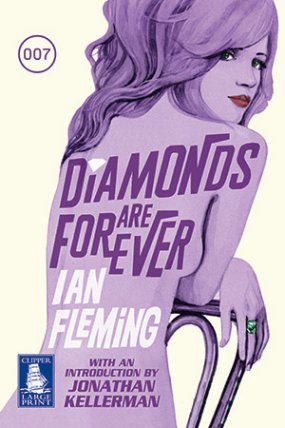|
Spectreville - Ian Fleming's Diamonds Are Forever

'Meet Tiffany Case, a cold, gorgeous, hard-boiled blonde; the kind of
girl you could get into a lot of trouble with - if you wanted. She
stands between James Bond and the leaders of a diamond-smuggling ring
that stretches from Africa via London to the States. Bond uses her to
infiltrate this gang, but once in America the hunter becomes the
hunted. Bond is in real danger until help comes from an unlikely
quarter, the ice maiden herself...'
Diamonds Are Forever is the fourth James Bond novel in the series of
books written by Ian Fleming and was originally published in 1956. The
plot revolves around 007's mission to stop a diamond-smuggling
operation being conducted out of Africa and trace the 'pipeline' back
to the mysterious 'ABC' in London. Bond is asked to replace arrested
courier Peter Franks and told to investigate the 'House of Diamonds',
run by Rufus B Saye, who the government suspect may be involved in the
London end of this global smuggling line. Bond is also required to
rendezvous with the enigmatic Tiffany Case, who tells him to deliver
the diamonds to Michael 'Shady' Tree in New York. As 007 prepares to
depart, he is informed by M that Saye is in fact Jack Spang, a
connected mobster from the 'Spangled Mob' in Las Vegas. Bond is warned
that if he makes 'dangerous contact' with the mob he is to abort his
mission and leave things to the FBI...
It's always interesting to me to see how diverse opinions are sometimes
on the merits of individual James Bond books. For every Fleming novel
it appears you can find one reader who regards it as refreshingly bold
and the best thing he ever did and another reader who thought it was
absolutely dreadful and the nadir of the series. Diamonds Are Forever
is no different and the main bone of contention here is that Ian
Fleming, possibly the most English person that ever lived, plunges 007
into the world of American gangsters, drawing inspiration from Raymond
Chandler and American crime fiction in general. While some enjoyed this
more down to earth approach and threat, others were not terribly
convinced by Fleming's depiction of this world and those who inhabit
it.
Fleming's attempt here to place Bond into a new environment of sorts is
quite interesting but sometimes seems rather stereotypical and
cartoonish in its depiction of Cosa Nostra types. As usual though,
Fleming gives us a lot of research and background on the subject at
hand, here concerned with gambling and the history of the mob and other
related bits and pieces. 'There's nothing so extraordinary about
American gangsters,' says an unperturbed Bond to M at the start of the
novel. 'They're not Americans. Mostly a lot of Italian bums with
monogrammed shirts who spend the day eating spaghetti and meatballs and
squirting scent over themselves.'

Bond has to go undercover in Diamonds Are Forever but you never quite
get that underlying edge of danger and tension that you feel for him in
some other Bond books. The villains here are just not frightening
enough and rather vague or absent at times. They lack the cultured and
enigmatic air of the usual Bond villains who just love to dine with
007, match wits and explain their nefarious schemes in a civilised
fashion. Seraffimo Spang is a Las Vegas mafia boss obsessed with the
Old West and while he's a mildly interesting character he's not exactly
Auric Goldfinger. The setting of the novel does inspire Fleming though
to paint some nice backdrops as 007's mission unfolds - 'Bond woke on
time and there was a wonderful freshness in the air as he followed the
limping figure of Leiter through the half light that filtered through
the elms among the walking stables. In the East, the sky was pearly
grey and iridescent, like a toy balloon filled with cigarette smoke,
and among the shrubs the mocking birds were beginning their first
song.'
Better are henchmen Wint and Kidd although they don't feature in the
novel an awful lot really. Their cruise ship encounter with 007 is one
sequence here that made it into the very different film version
starring Sean Connery - in a fashion - and they give Bond one or two
uncomfortable moments in the book. 'Wint,' said Leiter flatly. 'And the
other guy was Kidd. Always work together. They're the top torpedoes for
the spangs. Wint is a mean bastard. A real sadist. Likes it. He's
always sucking at that wart on his thumb. He's called Windy. Not to his
face that is.' Wint and Kidd are fairly obviously supposed to be gay
which, bearing in mind this book was written a very long time ago,
leads to one or two terms that would not pass any stringent political
correctness tests today.
Elsewhere, Tiffany Case is certainly a well fleshed out and vivid Bond
woman and her relationship with Bond is always interesting and includes
some nice verbal sparring. 'Listen, Bond,' said Tiffany Case. 'It'd
take more than Crabmeat Ravigotte to get me into bed with a man. In any
event, since it's your check, I'm going to have caviar, and what the
English call cutlets, and some pink champagne. I don't often date a
good-looking Englishman and the dinner's going to live up to the
occasion.' Felix Leiter, after the events of Live and Let Die, is now a
'Pinkerton' agent or private detective, but seems fairly chipper about
it. Leiter's relationship and banter with James Bond is always
enjoyable and Diamonds Are Forever is no different in this
respect.
Diamonds Are Forever has a slight jet-lagged atmosphere which I quite
like with Bond frequently on a plane and the usual Fleming obsession
with food is also in place. Fleming's strong descriptive qualities also
greatly aid the atmosphere of the novel with some nice detail about the
American locales Bond visits like Saratoga. 'The first thing that
struck Bond about Saratoga was the green majesty of the elms, which
gave the discreet avenues of colonial-type clapboard houses some of the
peace and serenity of a European watering place. And there were horses
everywhere, being walked across the streets, with a policeman holding
up the traffic, being coaxed out of horse-boxes around the sprawling
groups of stables, cantering along the cinder borders of the roads, and
being led to work on the exercise track alongside the race-course near
the centre of town.'
While some prefer the more down to earth villains projected here,
personally I had a lot more fun reading about Bond's tangles with Auric
Goldfinger and Hugo Drax, more larger than life villains plotting more
fantastical criminal capers. These characters, and others like them,
seemed to be more fleshed out than the baddies in this story with a
more protracted build-up. Here, you never quite feel as if Bond's
mission is that epic or exciting, although Diamonds Are Forever is
certainly readable and interesting on the whole.
Diamonds Are Forever is far from the best example of Ian Fleming's
James Bond novels but it's by no means a bad book. Readable but not a
classic.
- Jake
c
2010
Alternative 007
|

|


